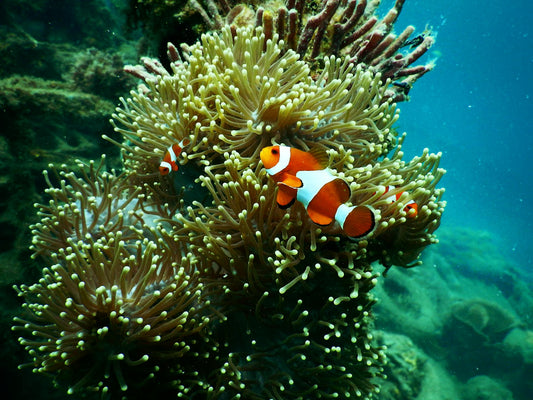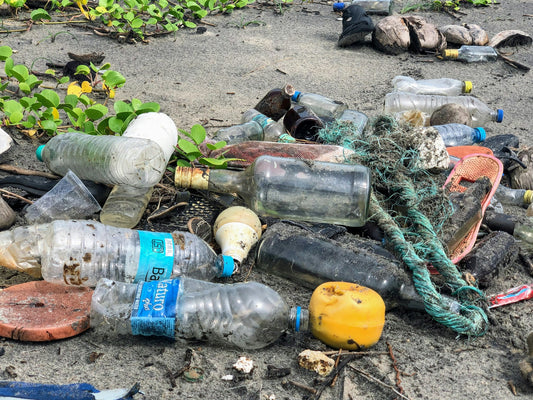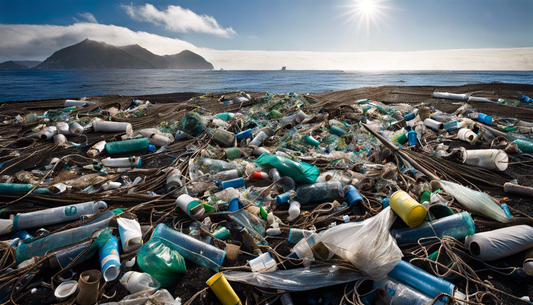Share
This article is part of our series on microplastics.
Microplastics, defined as plastic particles smaller than 5 millimeters, have become a pervasive environmental issue in agriculture. Their entry into waterways through agricultural practices poses significant threats to ecosystems and human health.
This article explores how microplastics infiltrate waterways from agricultural sources, particularly through irrigation systems and the use of pesticides. We also highlight case studies that illustrate increased contamination in affected areas
Sources of Microplastics in Agriculture

Irrigation Systems
Irrigation practices are a primary pathway for microplastics to enter aquatic ecosystems. Many farmers utilize treated wastewater for irrigation, which can contain microplastics from various sources. Studies indicate that microplastics can be present in significant concentrations in irrigation water, especially when sourced from contaminated rivers or lakes.
For example, research has shown that microplastics can be introduced into crops via irrigation systems that utilize surface water contaminated with treated or untreated effluent, leading to potential accumulation in the food chain.
Pesticides and Fertilizers
The application of fertilizers and pesticides is another critical source of microplastics in agriculture. Many fertilizers contain plastic coatings designed to control nutrient release, which can degrade over time into microplastics.
Additionally, biosolids—organic materials recycled from wastewater treatment—often contain microplastics due to the breakdown of larger plastic items during processing.
A study found that fields treated with biosolids had higher concentrations of microplastics in runoff compared to those treated with manure or left untreated.
Plastic Mulching
Plastic mulching is the practice of using a plastic film to cover crops. The film is supposed to help with water conservation, protection against the elements, weed control, and pest protection.
Plastic mulching has been a common agricultural practice for over fifty years, contributing significantly to soil microplastic pollution. As these plastic sheets degrade under environmental conditions, they break down into smaller particles that can be washed away during rainfall events, leading to increased runoff contamination.
Case Studies Highlighting Increased Contamination

Mississippi Delta Study
A recent study conducted in the Mississippi Delta assessed microplastic pollution in agricultural runoff. Researchers collected runoff samples and found an average concentration of 237 microplastic particles per liter, with polyethylene and polyvinyl chloride being the most prevalent types.
The study demonstrated that biochar could effectively reduce microplastic concentrations by up to 92% when used as a filtration medium. This highlights the potential for innovative solutions to mitigate microplastic pollution from agricultural runoff.
Biosolid Application Impact
Another significant investigation focused on the effects of land-applied biosolids on microplastic concentrations in runoff.
Biosolids are a byproduct of the wastewater treatment process. While it has long been common to use animal manure as fertilizer, many farmers are now using biosolids, because they are cheaper and more accessible.
A study quantified that approximately 64 billion microplastic particles could potentially be transported to surface waters annually from biosolid-amended corn and soybean fields in the U.S..
This alarming statistic underscores the role of agricultural practices in contributing to widespread environmental contamination.
Implications for Ecosystems and Human Health
The presence of microplastics in the environment poses serious risks to wildlife and human health. While many studies have emphasized the impact of microplastics on aquatic ecosystems, newer research also shows how the small particles infiltrate our food chain through fruits and vegetables.
Especially root vegetables have been tested for worrying levels of microplastics. The microplastics are filtered through the root and stem, which means root vegetables like carrots or potatoes show the highest concentrations.
Research indicates that microplastics can harbor harmful pathogens and pollutants, potentially affecting wildlife. Furthermore, as humans consume contaminated food, there is growing concern about the implications for human health.
Read more about the effects of microplastics on human health.
Sustainable Agriculture is Only A Small Part of the Solution

The infiltration of microplastics into waterways from agricultural sources is a pressing environmental issue that requires immediate attention. Through irrigation systems, pesticide use, and plastic mulching practices, agriculture significantly contributes to this problem.
The shown case studies illustrate not only the extent of contamination but also potential mitigation strategies such as biochar filtration. Addressing this challenge will require collaborative efforts among farmers, researchers, and policymakers to develop sustainable agricultural practices that minimize plastic pollution while safeguarding ecosystems and human health.
Last, but not least, we should all consider reducing our own plastic footprint. After all, the less plastic we consume, the more effective introduced solutions can be.
We hope you enjoyed this article. If you want to read more like this, make sure to check out our Blog and follow us on Instagram. If you are interested in truly sustainable products, check out our Shop.
If you want to engage in the discussion, feel free to leave a comment below.








